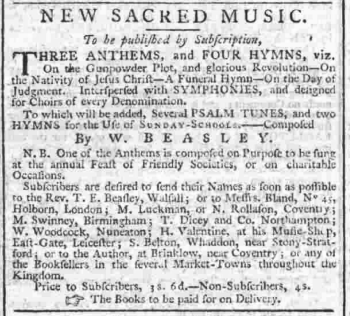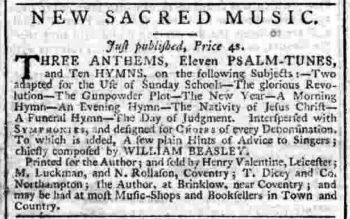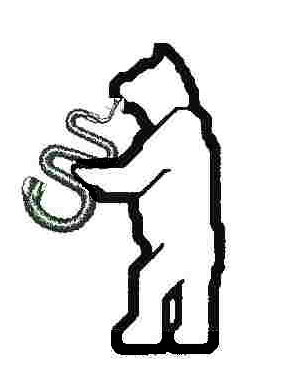|
|
A Key to a
Mystery
As published in the
Autumn edition
West Gallery, The Newsletter of the West Gallery Music Association,
September 2016.
|
|
Sometime shortly into this
millennium, having started a quire in Warwick, I set out to track
down music by Joseph Key, who of course is a composer with
Warwickshire connections, having lived in Nuneaton for the latter
part of his life and been buried there in St Nicholas’ Churchyard on
20 September 1784.[i]
On the way to Nuneaton public library[ii]
I contacted Warwick County Record Office who suggested that as
Immanuel’s Ground Quire practised just over the road from their
premises I should look in and see what they held by way of music.
There I found four fairly typical old books of choir music,
[iii]
roughly quarto size, which had obviously seen a good deal of use.
In two of them there was indeed music by Joseph Key. His first
book, both first and second editions,[iv]
were present in some shape or form, but pages were missing
and several of the other individually printed books included in the
binding of the choir books had had their front and end pages
removed. This led to a certain amount of inspired guesswork as to
what had been lost, and in at least one case what the book actually
was.
|
|
Two of the choir books
contained both printed and manuscript music, and thus, forsaking my
search for Key, I started browsing through the manuscript sections
where I found the usual collection of anthems and psalms. However,
one of these choir books[v]
also included a piece entitled A Hymn on the Gunpowder Plot by Mr
Dodderidge, a three-part hymn with a short closing symphony and
interesting harmonies and ornamentation, worthy of copying then and
there. The first two couplets are:
Salvation
doth to God belong,
His power and
Grace shall be our song.
His hand hath dealt a secret blow
And terror strikes the haughty Foe.
When transcribed and sung by
Immanuel’s Ground, this piece quickly became one of our
favourites – so much so that it is included in our choice of music
for the ‘Gold Book’ Let Our Joys Be Known, published by WGMA
in 2010, and we have been claiming it as one of our discoveries ever
since.
|
|
In the same choir book, the
manuscript additions[vi]
follow John Geary’s Fifteen Anthems, a Carol, and several
Hymns for Certain Days, printed and sold by the Author at
Caldecote, near Nuneaton, [1781]. The carol in the title of Geary’s
book turns out to be that known in the Oxford area as The Baldon
Carol, it having been found (without the ornamentation in the
printed version) in a manuscript from Marsh Baldon, Oxfordshire, and
named as such by Dave Townsend. The first part of the choir book is
Capel Bond’s Six Anthems in Score…’ 5th Edition. [n.d. -
First Ed. 1769.]
|
|
The choir book in question
is inscribed twice on the inside front cover in small writing
‘Jonathan Sodin’, which is repeated again in bolder handwriting on
the front cover of Capel Bond’s book, followed by the date May 25th
1785. The latter inscription has been partly eradicated by smearing
ink over it, and is replaced by another on the inside front cover,
stating ‘This Book for the Use of Harboro’ Church April 3rd 1815’.
Two further choir books in this collection bear this statement, to
which has been added ‘At the expense of the Parish’.
|
|
Another book bound into one
of these choir books is Parochial Harmony by John Alcock Jr.,
which was published in 1777: the title page describes the collection
as ‘Expressly Composed for the use of Country Choirs, By J. Alcock,
Junr. Batchelor in Music and Organist of Walsall’.
|
|
Jonathan Sodin (or Soden -
he preferring the former) was included in the Lists of Subscribers
for both the publications by John Geary and John Alcock; fortunately
these lists had not been removed by whosoever bound the choir books
together. Sodin is recorded on John Alcock’s list as living in
Comb-Fields, Warwickshire; Soden as well as William Wakelin are
recorded as living within the same parish by John Geary. Alcock
lists John Bird and William Watts Sodin[vii]
as well as Jonathan Sodin living in Comb-Fields, with William Adler,
George Bayliss, Samuel Colledge, William Goodman, Jnr. and John
Jones, all living in Brinklow and purchasers of single copies of
their respective books. William Beasly, Char. Bird, and J. Sodin of
Combfields are also listed elsewhere as subscribers.[viii]
|
|
Combe Fields, about 5 miles
east of Coventry, was originally the parish of Smite and later
extraparochial; it is now a civil parish containing no village.
Smite church, together with its chapel of Brinklow, was given to
Kenilworth Priory, and at the dissolution of the priory the church
was allowed to decay, finally being incorporated into the house now
known as Peter Hall.[ix]
The former Combe Abbey gives its name to the area; the parish is
just over 4,300 acres and what used to be a Cistercian abbey has,
over the years since the Dissolution, become the Coombe Abbey Hotel
and Leisure Park. Doubtless the abbey’s lands were a great deal
larger before the Dissolution.
|
|
An important point in the
context of ecclesiastical administration is that, for a time,
records of Combe Fields fall under Brinklow, this being the
immediately adjoining parish to the east. Jonathan Sodin is
recorded in the St John’s Church, Brinklow, parish registers as
being baptised there on 16th May 1741, and marrying Sarah Bird on
30th January 1766. Sarah is possibly the daughter of the John Bird
who is recorded as one of the subscribers, and who also was a fairly
close neighbour of the Sodin family in Combe Fields. Between 1766
and 1781 Jonathan and Sarah had 11 children, 6 boys and 5 girls, all
of whom were christened in the parish church of St John the Baptist
at Brinklow. Their first-born, Jonathan, died and the second child
was named after him
|
|
Jonathan Sodin ‘of Combe
Fields’ was buried in St John’s churchyard on 7 July 1799, and an
inventory of tombstones and memorial inscriptions made by the
Brinklow Women’s Institute shows that his tombstone stood against
the south wall of the church to the west of the transept.[x]
An inspection in 2015, however, showed it to be missing. A number
of tombstones which seemed once to have stood against the church
wall were found lying face down on the steep-sided part of the
churchyard grass, presumably to prevent damage from mowing. Without
raising them individually, there is no knowing whom they
commemorate.
|
|
Jonathan dated his choir book
May 25th 1785, when he would have been 44 years of age, and just
before his son William’s apprenticeship to a carpenter in Coventry.
With his close involvement with the church at Brinklow (he is to be
found several times as a witness to marriages), and the number of
other men who had purchased similar music at about the same time,
there is every reason to suppose that the church had a strong quire.
Indeed, it is said locally that there was a west gallery accessed
from the tower staircase, and there appear to be positions at the
west end against the tower where this might have been fixed. No
written record of this gallery, however, has so far been found.
Sadly this must have all come to an end in too short a time, as
Jonathan died in 1799 and his son, also Jonathan and to whom these
books may have passed, was buried in Coventry on 8 August 1811. By
1815 the choir books had been transferred to the nearby parish
eastwards of Harborough Magna, purchased ‘at the expense of the
parish’.
|
|
Backtracking to the Hymn
on the Gunpowder Plot, Mr Dodderidge is obviously Philip
Doddridge who reopened a Dissenting Academy originally started by
John Jennings, and attended by him in the 1720s. After persuasion
to do so by Isaac Watts,[xi]
Doddridge set up his own Academy in Marefair, Northampton, in
January 1730, at the same time becoming pastor of the Castle Hill
church.[xii]
He wrote the words, but this leaves wide open the question
as to the identity of the composer of the Gunpowder Plot hymn.
|
|
Another piece amongst the
manuscript section at the back of the same choir book, and in the
same hand as the Gunpowder Plot hymn, is one entitled An Hymn for
Christmas Day, by Mr Beasly. Having set this music for
Christmas 2014, several of the Quire started to compare the
similarities in style between the two pieces, leaving us to wonder
whether they were both by ‘Mr Beasly’, but certainly not by the
Beesly who is thought to have written Otford, and who
certainly once lived in his father’s farm cottage at Dry Sandford,
near Wootton, just up the road from where Sheila and I live on the
western edge of Oxford.
|
|
Since its publication in
book form, there has been added to Nicholas Temperley’s on-line
Hymn Tune Index an entry for an unclassified book: *UC 12.
Warwick, Warwickshire County Record Office, Parish of Harborough
Magna DR 405/38. (An English collection of hymns, lacking title
page.)[xiii]
|
|
A subsequent researcher also
found advertisements for the book, because Temperley’s list of
missing and incomplete books includes the following:Beasley,
William, of Brinklow, near Coventry. Three Anthems, 11 Psalm
Tunes, and 10 Hymns. Brinklow: for the author, 1789.[xiv]
|
|
There was considerable rejoicing
in the Macadam household therefore when, in October 2014, Sheila
came across the key to proving the connection: two advertisements in
the Northampton Mercury of 14 November 1789 and the previous
December 1788. The earlier advert called for subscribers for the
Beasley book, who would only have to pay 3s 6d instead of the
published price of 4s 0d, and the later one confirmed that the book
was ‘just published’ by 14th November 1789.
|
|
The final piece of evidence
was the reference in both advertisements to the Hymn on the
Gunpowder Plot being included. This tune now unfortunately
survives only in manuscript form, for by another quirk of fate
someone has literally cut pages 21 & 22 out of Beasley’s book with a
knife, possibly because of the hymn’s anti-Catholic sentiments. One
is left wondering what the other two pieces of music might have been
on the reverse of that lost page!
|
|

Northampton Mercury,
December 1788
|
|

Northampton Mercury, 14 November
1789
|
|
No Subscribers’ List for
Beasley’s publication survives the ruthless disposal of what was
considered immaterial for a choir book, but at least one copy of his
book remains, that in Warwick Record Office, DR 405/38, and catalogued as *UC 12 in the Hymn Tune Index.[xv]
The missing Gunpowder Plot hymn is in choir book DR 405/39.
Of William Beasley himself
there is more historical background to be related, but readers will
have to wait for a subsequent article before this is
revealed.
Edwin M Laming Macadam
Oxford, UK.
© September 2016 |
|
______________________________________ |
| Notes |
[ii]
Unlike
George Eliot whose history is so well documented in and around
the Nuneaton area, there is very little in the Nuneaton public
library relating to Joseph Key except for his four books of
music bound as a complete edition. So far Key remains an enigma
both to them and to the outside world, although he does gain a
little more prominence as time passes and his works are
performed.
[iii]
Warwick
Record Office Refs: DR 397/76, 405/38, 405/39, and 405/40.
[iv]
Joseph
Key, Nuneaton, Warwickshire, Eight Anthems, on various
occasions. [Book 1] Nuneaton: for the author, 1774. The
second edition, including two added canticles for Morning
Prayer, his much acclaimed Te Deum, and the Jubilate,
is dated 1776.
[vi]
It is
interesting to note what the singers had in their repertoire.
Other than major anthems by the more recognised church composers
of the day, there is a bias towards local composers in the
smaller manuscript pieces, with compositions by John Valentine,
Mr Greatorex, Mr Beasley, Mr Blockly, and ‘Sheffield’, as well
as psalm tunes and collects by Key and Alcock, Jnr.
[vii]
William Watts Sodin is Jonathan Sodin’s brother.
[viii]
Dr.
Edward Miller [of Doncaster]. The Psalms of David for the use of
parish churches ... The words ... Tate & Brady ... Rev'd George
Hay Drummond. London, c. 1790.
[x]
WRO Accession No.
Z0609(SM). Brinklow Memorial
Inscriptions; including plan of monuments in the church and churchyard
made to accompany W.I. survey on microfilm (MI 376).
[xii]
Tessa
Whitehouse, Dissenting Education and the Legacy of John
Jennings, c.1720-c.1729.
[xiii]
To which is added by Nicholas Temperley: [N.p.]: [c.1785].upright;
engraved. 19 tunes (2–4). <Fh> Bound with GearJFPT
(1781–), KeyJA3 (1785), and HillJCM2 a (1787).
[xiv]
Temperley’s comment in HTI: Advertisement in the
Leicester Journal
as ‘lately published, 18 December 1789’; a call
for subscriptions had appeared there on 2 January 1789. Added
to HTI database in 2006.
[xv]
HTI
database reference for Beesley’s book is BeasWAPTH (1789) e.
|
|

